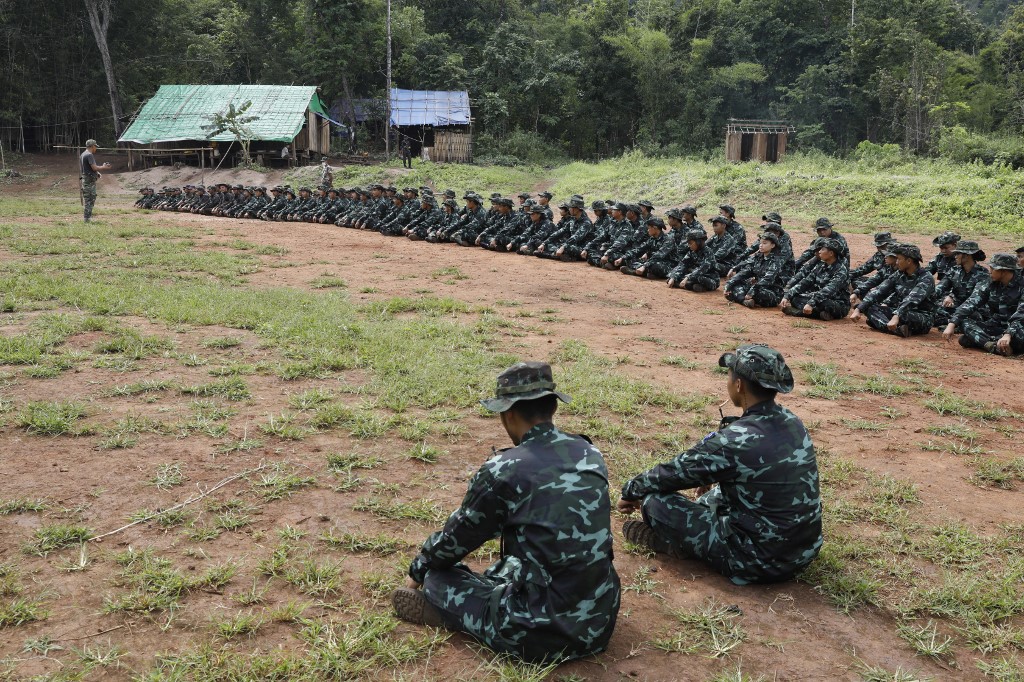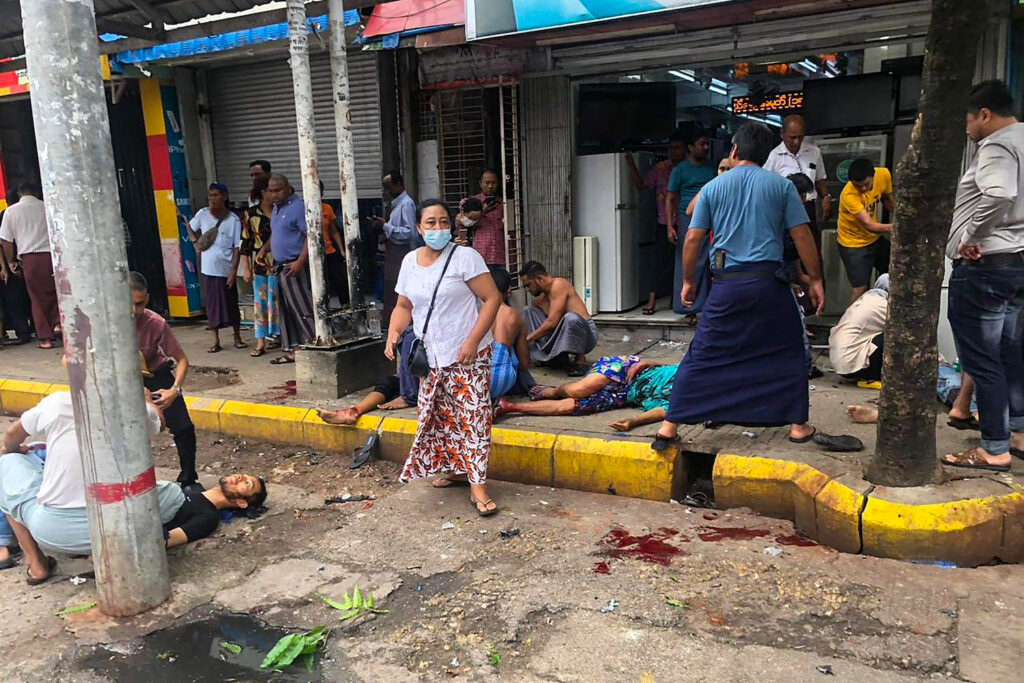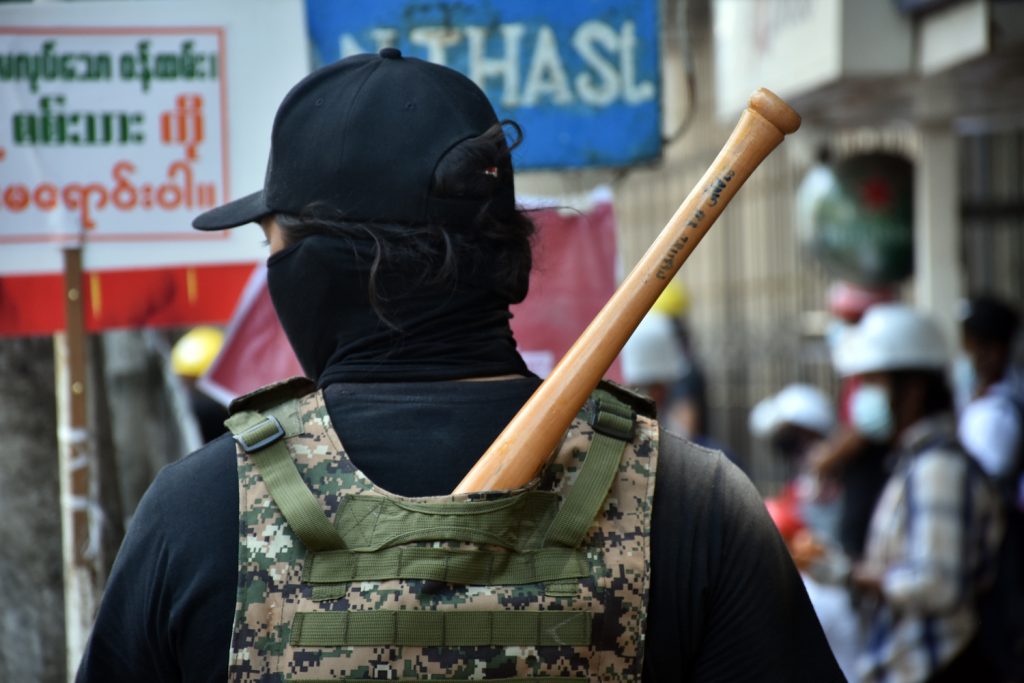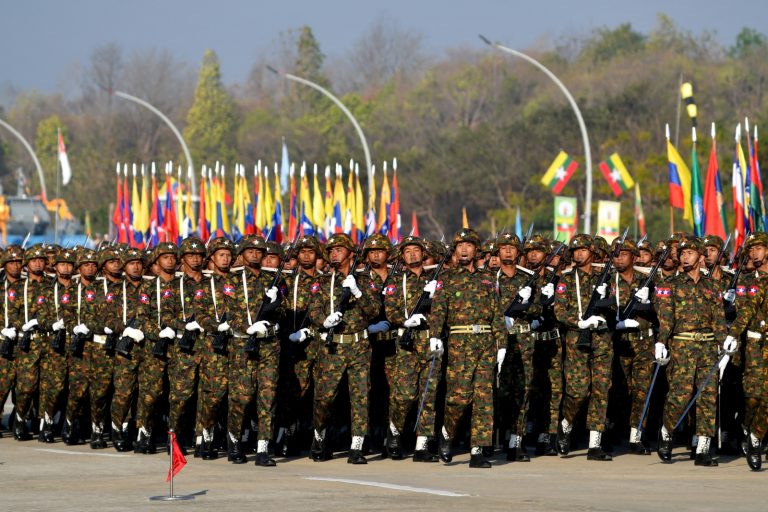A core group of committed urban fighters continue to wage a guerrilla war against the military, despite mass arrests, civilian casualties, limited success and dwindling financial support.
By FRONTIER
After the military gunned down hundreds of peaceful protesters, 23-year-old Ko Zarni* banded together with other like-minded youths in April last year. Calling themselves “underground guerrilla” fighters, or UGs, they launched attacks against security forces in the commercial capital Yangon, mainly employing bombs and drive-by shootings.
Scores of similar guerrilla groups formed at the same time, marking the moment Myanmar’s protest movement transformed into armed resistance in response to increasingly brutal violence by security forces. The junta’s local officials began to be assassinated on an almost daily basis, and the urban struggle seemed to escalate with the killing of five police officers on a Yangon train in August last year.
“We have been fighting for almost two years,” Ko Zarni told Frontier in November. “We can’t get arrested now. We have too much to do.”
But despite these defiant words, many UGs in Yangon have been arrested, and armed resistance to military rule has largely faltered in urban areas, even as it enjoys unexpected success in rural parts of the country.
On October 30, junta-controlled media announced the arrest of 10 young members of the Inya Urban Force (IUF), accusing them of orchestrating the killing of former Brigadier-General Ohn Thwin, one of the most high-profile assassinations since the February 2021 military coup. On November 3, it said another 21 resistance fighters had been arrested with weapons and ammunition between October 18 and 24 in Yangon’s outer Dala Township, accusing them of robbing banks and carrying out assassinations.
The arrests were just the latest in a series of major blows to the armed resistance in Yangon, perhaps best illustrated by the capture and execution of prominent activist Ko Jimmy and popular politician Phyo Zeyar Thaw, accused of leading the movement.
“Sometimes we think about Ko Maung Kyaw as if he were still with us,” Ko Zarni said, using a nickname for Phyo Zeyar Thaw, who he claimed worked closely with his group. “If he were still with us, we would not have lost as many lives.”
Ko Zarni said in recent months, military intelligence has become more effective, and informants are camouflaged among ordinary citizens.
“If they caught one of us by following us or [making unannounced home visits on the pretext of] checking the overnight guest list, they’d force him to talk to us and act normal. Then they’d make him lure us somewhere else and arrest us once we arrived,” he explained.
Ko Zarni said security forces also sometimes pose as sympathetic members of the public, trying to meet in person to make donations. Other times, he said that he believes they monitor phone calls and check CCTV tapes for vehicle licence plates used in attacks.
Ko Zarni said the executions, and the deaths of his comrades tortured in custody, did not make UG fighters more afraid, but only angered them and strengthened their resolve.
“This blood debt must be repaid no matter what it takes,” he said.
But he acknowledged that the armed resistance movement in Yangon has faltered lately and said this is due to a combination of military crackdowns, fatigue and a lack of support.
“Because we are running low on manpower, it is becoming more difficult to carry out missions,” he said, explaining that some UG fighters have fled to the countryside to join the more effective rural uprisings, while others have had to go into hiding.
“But we will never stop fighting,” he insists.

Fleeing the city
Ko Naing*, a former UG in Yangon, fled to rural Bago Region eight months ago, after members of his cell began getting arrested one by one.
“Eventually, one of my comrades who was staying in the same house as me got arrested while he was out scouting, so then I was sure they would also have my name,” he said, explaining he left the city immediately after.
Like many other young revolutionaries, Ko Naing had been trained by the Karen National Union, an ethnic armed group that operates in Bago and Tanintharyi Regions, as well as Kayin and Mon States.
Most of his fellow trainees joined a People’s Defence Force. PDFs are officially the armed wing of the parallel National Unity Government, appointed by elected lawmakers in defiance of the coup, although the term is often used generally to refer to any armed group formed in opposition to the coup. Ko Naing, however, decided to return to Yangon at first to be a UG, but was able to join his former fellow trainees in the PDF when he was forced to flee.
“Some of us had to leave our duties in the city and return to the jungle due to safety concerns, but we have joined hands with those who are fighting here,” he said.
Resistance groups formed since the coup have teamed up with more established ethnic armed groups in Kayin, Kayah and Kachin states, while also stunning the military in Sagaing and Magway regions in Myanmar’s central Dry Zone, which had not seen significant armed conflict in previous decades. But while these groups have managed to dismantle the junta’s administration in many rural areas, major towns and cities remain in the military’s grip.
Ko Zarni said UGs are also suffering from a lack of financial support, with limited funds from the NUG and increasingly dwindling donations from the public.
Ma Su Mon*, a 32-year-old resident of Yangon’s Insein Township who says she feels a thrill whenever she hears a bomb blast or gunshot, is among the UGs staunchest supporters.
“Whenever I hear about military or police casualties in our neighbourhood, I feel great. They deserve it since we’ve lost many on our side, such as those who fell in the protests and the victims of the military’s bombings in rural areas in Kachin and Kayin states,” she said, adding that she donates to armed groups operating in Yangon once or twice per month.
“I know that they are giving their lives for us, the people, so we should help them financially,” she said.
But fewer and fewer citizens appear able or willing to sustain this level of support.
“We are running low on funds to purchase weapons and materials. If the public donated to us more, we could carry out more missions,” Ko Zarni said. At the same time, prices of basic commodities are rising across the country, due to a combination of inflation and a deteriorating kyat, making life in Yangon increasingly expensive.
A member of UG group God’s Hand Forces, who uses the nom de guerre Sayar Kyaung, agreed.
“Each group has their own struggle to survive,” he said, adding they often find it hard to pay “for food and accommodation, let alone equipment. And they don’t get any help. So, they realise they can’t survive here and go back to the jungle. I’ve seen this happen to six or seven other groups I know.”

Botched attacks and civilian casualties
Other reasons for dwindling public support may include the high rate of civilian casualties that inevitably occur when staging attacks in densely populated urban areas, and the fact that rural PDFs have been much more successful.
Ma Htet Htet*, a 26-year-old from Yangon’s Kyauktada Township, told Frontier she used to donate to UGs regularly but has since shifted to funding PDFs, largely due to increased civilian casualties in UG attacks. She pointed to a bomb blast at a bus stop in May that wounded numerous civilians as an example.
“I don’t believe our [UGs] would intentionally attack civilians, and I guess these casualties are inevitable when it comes to war,” she said. “I felt a bit guilty even though these incidents were not done by the UGs I donated to.”
Although members of the NUG suggested it may have been a military false flag attack, the bus station incident did indeed appear to be an accident – video footage viewed by Frontier shows an explosion as a man looks inside his bag, presumably in the process of transporting the bomb to its intended target. But it is far from the only case.
There was also widespread public backlash to the October bombing of Insein Prison, also in Yangon, which reportedly killed three prison staff but also five civilian visitors, including a child and the mother of a prominent political prisoner.
But many in Yangon stand by the UGs, like 28-year-old Sanchaung Township resident Ko Aung*, who said security forces killed by guerrilla attacks “get what they deserve for killing our people”.
“But the consequences are unfortunate if a bystander or our own people get hurt during the incident… I don’t believe our PDFs would hurt civilians on purpose,” he said, adding that residents should be more careful and listen to warnings from UGs.
Ko Naing said groups like his operating under the NUG’s defence ministry typically exercise more restraint, as they are required to agree to a military code of conduct to join the parallel government’s forces.
“We have to abort the mission if even one civilian is spotted at the mission site, even if we could kill a high number of the enemy,” he said, adding that most groups will offer a “formal apology” and some financial compensation to the families of any civilian victims.
“In the worst-case scenario, we are all prepared to receive punishment from our leaders once we see this [revolution] through,” he said.
Ko Zarni and Saya Kyaung said in response to mounting challenges, they try to focus on targeting higher-ranking regime officials, sometimes taking weeks or even months to plan attacks. But despite this, high-profile assassinations remain few and far between.
The NUG claims that over 220 junta affiliates were killed in attacks between April and October in southern Myanmar, the majority of which occurred in Yangon. But it’s not clear if all these attacks occurred in urban areas, or if the number includes clashes in Yangon’s outer rural townships.
And other than Ohn Thwin, killed in September, the only other major target killed in Yangon was U Thein Aung in November of last year. The former navy officer was serving as chief financial officer of telecommunications company Mytel, which the military partially owns. Central Bank deputy governor Daw Than Than Shwe was shot in her home in April but survived the attack (and has since been promoted to governor).
Bomb blasts and shootings remain a near-daily occurrence in Yangon, although they seem to do little to loosen the junta’s tight grip on the city, where protest activity has been relegated to hugely risky flash-mob demonstrations, and where residents have largely been coerced into paying their electricity bills after a post-coup boycott.
Despite telling Frontier that God’s Hand Forces is focusing on bigger fish, Saya Kyaung’s list of recent attacks were all aimed at lower-level officials. They also failed to kill a single target but left multiple civilians wounded.
The most successful recent mission was a bomb attack at a military checkpoint in Insein Township on November 19, which he said injured four members of the security forces. But that same day, a God’s Hand Forces bomb in a toilet in Ahlone Township injured a 22-year-old civilian. It is unclear why the group planted a bomb in a public toilet, or if it had gone off accidentally, and Saya Kyaung did not respond to a follow-up question about the incident.
The following day, an attempt to assassinate a ward administrator in East Hlaing Tharyar Township instead left a 52-year-old female civilian with a gunshot wound to the shoulder. A bomb attack on another ward administration office in Thaketa Township that night failed to kill the intended target.
“The military is blind without them,” Saya Kyaung said, explaining why they target local administrators. “They help the military find the whereabouts of anti-coup fighters in their area, so it’s important to get rid of them to protect our people.”
Saya Kyaung said his group faces many of the same problems as Ko Zarni’s – heightened security concerns and dwindling numbers as more and more fighters head to the countryside. Saya Kyaung also left the city last year to receive training from an ethnic armed group but decided to return to Yangon to continue taking the fight to the junta in his hometown.
Saya Kyaung said it’s an “undeniable truth” that the UG movement in Yangon “can’t really take down the entire military institution”, but that it remained an important component of the revolutionary struggle because the attacks proved the junta is not in full control, and so was like “spitting in their faces”.
“We are doing this in order to nurture this small flame for as long as we can before the big flame comes,” he said.
*denotes a pseudonym upon request for safety reasons







